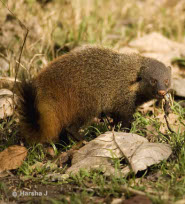 Body length: 43-53 cm (17 - 21 inch)
Body length: 43-53 cm (17 - 21 inch)Tail length: 40 cm (16 inch)
Weight: 1.36-2.73 kg (3-6 lbs)
The Striped-necked mongoose (Herpestes vitticollis) is the biggest Asian mongoose and is confined to Sri Lanka and India. On Sri Lanka, they can be sighted at the well-wooded habitats, particularly in the dry and moist deciduous forests where they prefer streams and rivers. Striped-necked mongooses have short limbs, with long fore-claws and the color of their fur can be dark brown, gray-yellow, or orange-yellow. The male weighs at around 3.1kgs and the females would weight much less.
A litter of the Striped-necked mongoose ranges from 2 to 3, and the newborns hunt with the parent until they are independent. This mongoose is frequently sighted in daytime at the open sea, and more often than not, it is solitary. Their diet consists mainly on crabs, as well as birds, small mammals (such as mouse deer), fish, frogs, grubs, insects and certain kinds of roots.
There are types of mongoose that are comfortable living near human settlements, but this specific mongoose is not one of them. They prefer to stay within a forest, and near a body of water.
Actually, two subspecies are recognized in India, these are: Herpestes vitticollis vitticollis, which can be distinguished by the chestnut-red color of the coat.
Keywords: stripe , black , brown , tail , diurnal
The Stripe-necked mongoose, striped-necked mongoose is listed as Least Concern (LR/lc), lowest risk. Does not qualify for a more at risk category. Widespread and abundant taxa are included in this category, on the IUCN Red List of Threatened Species
Namings for the stripednecked mongoose
A stripednecked mongoose group is called a 'mongeese or mongaggle'.Some facts about the
Striped-necked mongoose
Adult weight : 2.25 kg (4.95 lbs)
Maximum longevity : 13 years
Litter size : 3

Custom Search